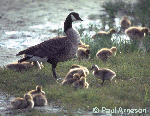Anchorage Coastal —
Wildlife Refuge
Fish and Wildlife
Birds
Anchorage Coastal Wildlife Refuge, with its extensive tidal flats, marsh communities, and alder-bog forest, supports some of the greatest numbers and diversity of birds in the Anchorage area. At least 130 bird species have been sighted in the refuge. Premier viewing occurs at Potter Marsh. Peak concentrations can be viewed during the spring migration from late April through mid-May when waterbirds stop on their way to breeding grounds to the north and again in late July and August when shorebirds begin to flock up in preparation for their migration to southern wintering grounds.
A diversity of waterbirds can also be found nesting in Potter Marsh. The most conspicuous and well-known is the lesser Canada goose, one of five subspecies of Canada goose found in Alaska. There are approximately 15-20 nesting pairs that provide entertainment each summer with the antics of their large "gosling nurseries." Other waterbirds commonly found in the marsh include mallards, northern pintails, northern shovelers, American wigeons, canvasbacks, red-necked grebes, horned grebes, yellowlegs, and northern phalaropes. Arctic terns and mew gulls are common nesters at the marsh. During migration, trumpeter or tundra swans, snow geese, short-earred owls, and an occasional pair of Pacific loons may be sighted. Northern harriers and bald eagles are often seen as well.
For a complete list of birds found in the refuge, download a bird checklist (PDF 567 kB) and review Appendix A of the Anchorage Coastal Wildlife Refuge Management Plan (PDF 4,558 kB).
Mammals
 Moose and muskrats are commonly found on the refuge. Moose are sometimes seen
feeding on aquatic or shrubby vegetation in Potter Marsh. The marsh supports a resident population
of muskrats that constructs "pushups," piles of vegetation used for feeding and resting,
scattered throughout the wetlands. An old beaver lodge at the back of Potter Marsh is a reminder of
the presence of beaver. Coyotes, least weasels, mink, snowshoe hares, red squirrels, voles, and shrews
are also residents of the refuge. Lynx, river otters, red fox, and black and brown bears are infrequent
visitors.
Moose and muskrats are commonly found on the refuge. Moose are sometimes seen
feeding on aquatic or shrubby vegetation in Potter Marsh. The marsh supports a resident population
of muskrats that constructs "pushups," piles of vegetation used for feeding and resting,
scattered throughout the wetlands. An old beaver lodge at the back of Potter Marsh is a reminder of
the presence of beaver. Coyotes, least weasels, mink, snowshoe hares, red squirrels, voles, and shrews
are also residents of the refuge. Lynx, river otters, red fox, and black and brown bears are infrequent
visitors.
Fish
 Rabbit Creek, Little Rabbit Creek, and Little Survival Creek, which flow into
Potter Marsh, all support populations of pink, coho, and chinook salmon and Dolly Varden char.
An ideal mix of fresh and salt water combined with a nutrient-rich environment contribute to the
importance of Potter Marsh as a juvenile fish-rearing area. Salmon fry, sticklebacks, and sculpins
are found throughout the marsh, providing food for summer birds, including arctic terns. Arctic
grayling have been observed very occasionally.
Rabbit Creek, Little Rabbit Creek, and Little Survival Creek, which flow into
Potter Marsh, all support populations of pink, coho, and chinook salmon and Dolly Varden char.
An ideal mix of fresh and salt water combined with a nutrient-rich environment contribute to the
importance of Potter Marsh as a juvenile fish-rearing area. Salmon fry, sticklebacks, and sculpins
are found throughout the marsh, providing food for summer birds, including arctic terns. Arctic
grayling have been observed very occasionally.
Campbell Creek, which flows through the middle of the refuge, supports wild populations of pink, chum, sockeye, and chinook salmon, Dolly Varden, and the ubiquitous sticklebacks and sculpins. The creek is stocked with rainbow trout and coho salmon. Northern pike were illegally introduced into the system in summer 2000.
